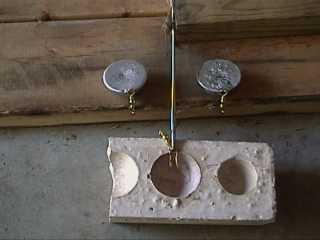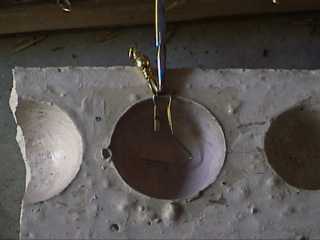 |
 |
|
|
Members
Fishing
Information
Other
|
Library of Knowledge
14 Ounce Weight Mold
This mold was made from a drywall mud tray that I poured in unsanded grout for tile. The drawback to using unsanded grout is that it will break relatively easily as you will see in the picture. The
other drawback is that you need allot of it to disperse the heat when pouring the larger weights over 10 ounces. The way to really go is to build a small box out of plywood for the bottom and 1x4s
on the sides. This way you have a try instead.
I sprayed the empty mud tray with some WD40 so the grout would not stick to the sides of the try. When mixing the grout up, try not to whip it as this will add air bubbles. I normally will add extra
water than I need so that it will form a crust on the surface and also be easier to work with. Find yourself several sizes of plastic or rubber balls. Once you pour in the grout and smooth it
around, push the ball down in the mixture. It is best to turn it while inserting. When you get the depth you want, just run duct tape across the top so that it will stay there. Shake the mold some
to even out the grout is another reason I added more water than needed..
As the grout starts to harden, take the tape off and lightly spin the balls creating a smoother surface in the insert of the mold. You can add a few drops of water if you see air bubbles when you
pull the ball out. Put the ball back in and respin to smooth it out more. Let this dry atleast 5 or 6 days to insure that all the water content is out. I will then spread a light coat of oil into
the cavities to prep the mold for pouring.
To make the clasp, I took a 3/0 snap swivel with the clasp and open and bent the clasp part. Refer to the picture to show placement before pouring the lead. The swivel helps with line twist so leave
it on. The one shown makes about a 14 ounce weight that is round on the bottom because of the ball and flat on the top.
TeamWhiskers August 19, 2007
Thank you for visiting.. |

